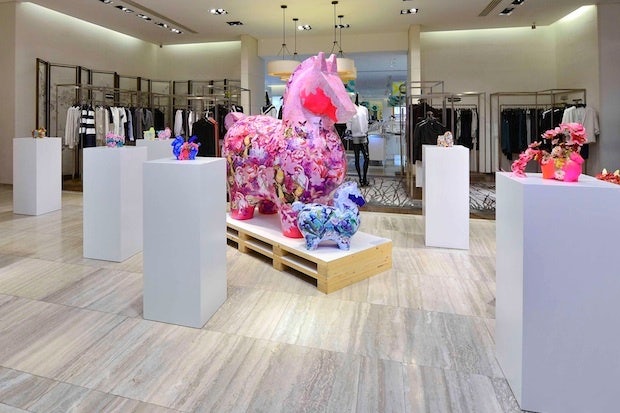
Lane Crawford's Chinese New Year display at ifc mall in Hong Kong. Although Xinhua reports that luxury sales for Chinese New Year declined overall, the retailer saw a rise in sales of its niche brands. (Lane Crawford)
Now that the Chinese New Year travel and spending season is over, retailers are assessing how much they benefited from the wave of Chinese travelers celebrating both in China and abroad. While the stock market saw a boost thanks to overall sales growth, the luxury market saw a distinct shift toward more consumer-oriented goods as the government’s anti-corruption campaign continues.
According to China’s Ministry of Commerce, retail sales grew by 13.3 percent to 610 billion RMB for the holiday period of January 31 to February 6. While still in the double digits, this pace is the slowest since 2009, down from 14.7 percent growth last year.
China’s state-run media is touting the fact that luxury sales growth has slowed this year as a result of the government’s crackdown on corruption. Xinhua reports that sales of luxury gifts such as expensive alcohol and rare seafood have “fallen sharply” during the Chinese New Year, with Fuzhou, the capital city of Fujian province, reporting a 70 percent sales decline in luxury alcohol in the first four days of the holiday. In addition, rare seafood sales were down 50 percent, despite the fact that “sales of ordinary goods went up in general.”
However, there were certainly areas where spending soared over the Lunar New Year. Retailers across the world sponsoring Chinese New Year marketing campaigns were likely happy to know that tourism revenue grew by 16.4 percent year-on-year, with overseas group trips climbing to 4.73 million over the holiday for an 18.7 percent increase. Global gambling destination Macau received over one million visitors, according to the Macau Government Tourist Office, marking a 13 percent increase from last year.
Although luxury gifting sales for corruption purposes reportedly declined, consumer-oriented niche labels did well. According to a report in Women's Wear Daily,
Lane Crawford Joyce Group saw double-digit sales growth at its Lane Crawford, Joyce and ImagineX stores in Hong Kong and Mainland China over the holiday period, according to a company spokeswoman.
ImagineX said its portfolio of contemporary brands including 3.1 Phillip Lim, Marc by Marc Jacobs, Juicy Couture, Club Monaco, DKNY and Alice + Olivia performed particularly well.
“We saw strong consumer appetite this Chinese New Year with robust double-digit sales growth in Hong Kong and China which exceeded expectations. This was largely due to Mainland Chinese consumers spending both in Hong Kong and at home,” said ImagineX managing director Thomson Cheng.
Another winning area over the Lunar New Year period was jewelry. The combination of China’s continued rush to buy gold while prices are low and many special-edition gold gifts offered for the holiday caused gold sales to soar during the period, driving up global prices. Xinhua reported that horse-themed jewelry sales rose 35 percent during the time period, and according to International Business Times:
Shanghai premiums for 99.99% purity gold climbed to $11 an ounce over London prices. They hovered at about $4 on 30 January just before China went on holiday. Trading volumes hit their highest in a month.
Caishikou, among the biggest jewellery retailers and dealers in Beijing, sold jewellery worth some 250m yuan in the first two days of the new year, according to data available on its website.
The shift toward consumer goods and away from luxury "gifting" products is likely to continue through 2014 as the Chinese government presses on with its anti-corruption campaign. According to Charles de Brabant, the founder of luxury consultancy Saint Pierre, in an interview with Women's Wear Daily, this means that brands will need to get more creative. “Luxury brands are playing on a single emotional dimension. For more-midtier brands, they can bring fun and excitement. Brands coming in that hit alternative emotional chords will have a better chance.”